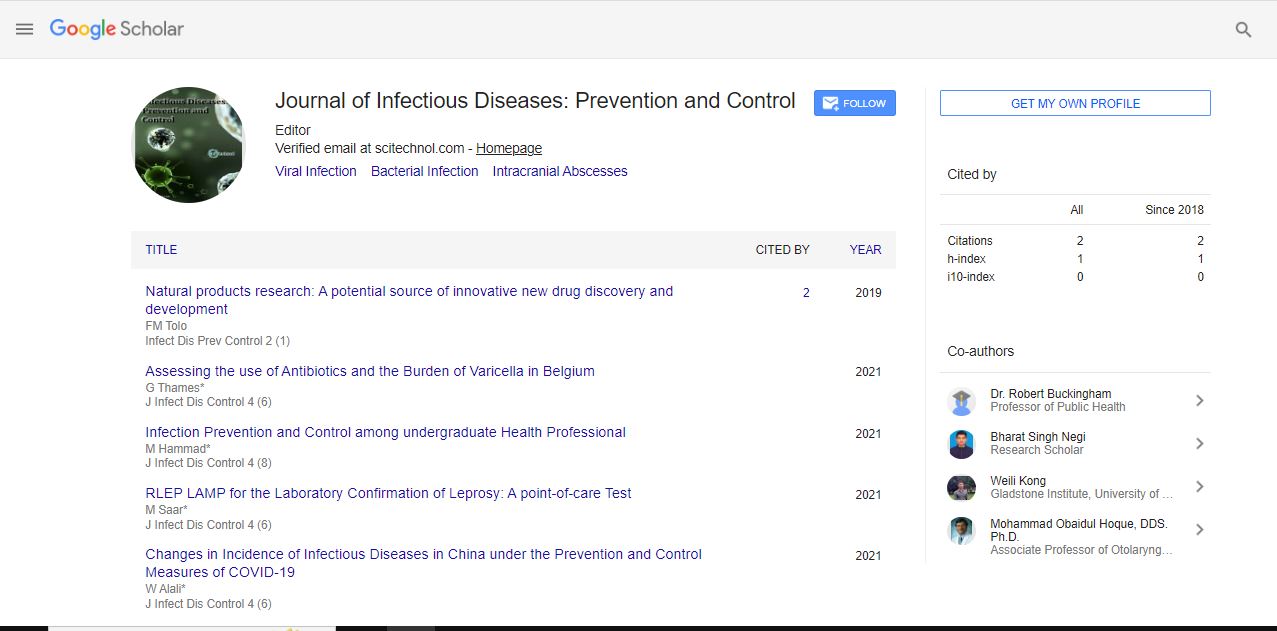Opinion Article, Vol: 6 Issue: 1
Preventive Measures Involved in Infection Control
Nicola Decaro*
Department of Veterinary Public Health, Faculty of Veterinary Medicine of Bari, Bari, Italy
*Corresponding Author: Nicola Decaro
Department of Veterinary Public Health,
Faculty of Veterinary Medicine of Bari, Bari, Italy;
E-mail: n.decaro@v.uniba.it
Received date: 21 February, 2023, Manuscript No. IDPC-23-95699;
Editor assigned date: 23 February, 2023, Pre QC No. IDPC-23-95699(PQ);
Reviewed date: 07 March, 2023, QC No. IDPC-23-95699;
Revised date: 14 March, 2023, Manuscript No. IDPC-23-95699(R);
Published date: 24 March, 2023, DOI: 10.36648/idpc.5.2.127
Citation: Decaro N (2023) Preventive Measures Involved in Infection Control. Infect Dis Prev Control 6:1.
Description
Infection control is a vital aspect of healthcare, encompassing a range of measures aimed at preventing the spread of infectious agents. Infectious agents can include bacteria, viruses, fungi, and parasites, which can cause a variety of illnesses and infections. In healthcare settings, infection control is critical to protect both patients and healthcare workers from contracting and spreading infections. Effective infection control measures can help reduce the incidence of Healthcare-Associated Infections (HAIs), which can have serious consequences for patient health and well-being.
One of the key principles of infection control is hand hygiene. Hand hygiene refers to the process of cleaning hands to remove dirt, bacteria, and other microorganisms. Healthcare workers are required to perform hand hygiene before and after patient contact, as well as after contact with objects or surfaces in the patient environment. Hand hygiene can be achieved through hand washing with soap and water or by using an alcohol-based hand rub. Hand hygiene is critical in preventing the transmission of infectious agents, as hands are a common route of transmission.
Another important measure in infection control is the use of Personal Protective Equipment (PPE). PPE includes items such as gloves, masks, gowns, and eye protection. PPE is used to protect healthcare workers from exposure to infectious agents, particularly when performing procedures that may generate aerosols, such as intubation or suctioning. PPE is also used to protect patients from healthcare workers who may be infected. Proper use of PPE is essential to prevent the spread of infectious agents, and healthcare workers must be trained on how to use and dispose of PPE properly.
Environmental cleaning and disinfection are also crucial components of infection control. Environmental surfaces, such as bed rails, bedside tables, and medical equipment, can become contaminated with infectious agents and contribute to the spread of HAIs. Regular cleaning and disinfection of these surfaces can help prevent the transmission of infectious agents. The use of appropriate disinfectants is important, as not all disinfectants are effective against all types of microorganisms. Healthcare facilities must have policies and procedures in place for environmental cleaning and disinfection, and staff must be trained on proper cleaning techniques and the use of disinfectants.
Infection control also involves the use of isolation precautions. Isolation precautions are measures taken to prevent the spread of infectious agents from patients who are known or suspected to be infected. Isolation precautions can include placing patients in private rooms, using PPE when caring for the patient, and limiting patient movement outside of the room. Isolation precautions are used for patients with highly infectious diseases, such as tuberculosis or Ebola, as well as for patients with infections that are easily transmitted, such as Methicillin-Resistant Staphylococcus Aureus (MRSA).
One of the challenges in infection control is the emergence of antibiotic-resistant bacteria. Antibiotic-resistant bacteria are microorganisms that are no longer susceptible to the effects of antibiotics, making infections caused by these bacteria difficult to treat. Overuse and misuse of antibiotics have contributed to the emergence of antibiotic-resistant bacteria, which can spread rapidly in healthcare settings. Infection control measures, such as proper hand hygiene and environmental cleaning, can help prevent the spread of antibiotic-resistant bacteria. In addition, antibiotic stewardship programs can help reduce the use of antibiotics, which can help slow the emergence of antibiotic-resistant bacteria.
Conclusion
Infection control is a critical aspect of healthcare, aimed at preventing the spread of infectious agents and reducing the incidence of HAIs. Infection control is not limited to healthcare settings. Infection control measures are also important in the community, particularly during outbreaks of infectious diseases. Measures such as vaccination, hand hygiene, and social distancing can help prevent the spread of infectious diseases in the community. Public health officials play a critical role in promoting infection control measures in the community and in responding to outbreaks of infectious diseases.
 Spanish
Spanish  Chinese
Chinese  Russian
Russian  German
German  French
French  Japanese
Japanese  Portuguese
Portuguese  Hindi
Hindi 